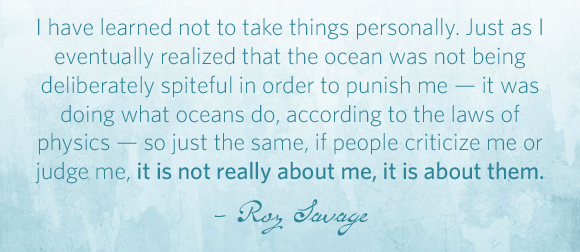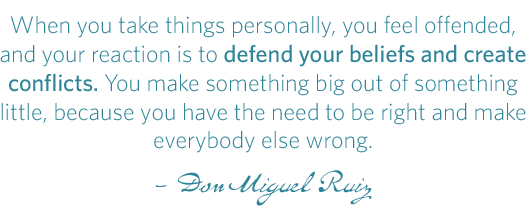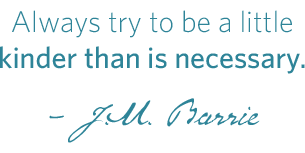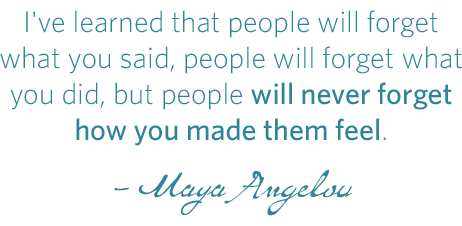
Small business owners spend a lot of time in communication with their clients and customers. For retailers, the holiday season can be a time of increased contact with customers, as well as increased stress. When you get to a point with your client or customer where they are not happy and are letting you know it, the best thing you can do to resolve things gracefully is:
DO NOT TAKE IT PERSONALLY
That’s right! This person does not know you, and you have no reason to worry about whether she likes you or not. Her complaint or concern is not about you, it’s about her perception of your business. Your job is not to make her like you, and your job is definitely not to prove to her that you are “right.” All you need to do is correct the problem to the best of your ability, and you’re gold.
My gang of workers at Aeolidia say I have the magic touch when it comes to talking to clients and they call me in when things get rough. My approach just boils down to The Golden Rule, and I treat our clients how I would like to be treated. When I have gotten an email from a client who seems angry (and may be speaking to me impatiently or unkindly), this is how I handle it.
1) Don’t take it personally.

It’s frustrating when my best intentions aren’t perceived positively, and it can tempting to feel like the client is judging me. I tell myself that when my client contacted me about her problem, she likely wasn’t thinking about me or my point of view. This is all about her and her problem, and making it about me isn’t helpful for either of us.
It’s easy to get a complaint and then mentally go back in my history with the client and find other problems where there were none or assume that they are unhappy with my company, with me, or that they’re trying to make things hard for me. If I start feeling this way, I tell myself that my only concern right now is the specific thing the client contacted me about, and that’s all I need to fix.
It’s not productive for me to feel like the client is mad at me, personally, and it’s not likely to be true anyway, as she is just thinking about her own problem. If I’ve been treating her kindly throughout the project, she’s got no reason to be mad at me.
2) Read her words from her point of view.
We mostly communicate with our customers over email, and it’s easy to misinterpret emails, or detect a negative tone when that wasn’t what our client intended at all.
To avoid communication breakdown, I try to read each message from a client with a clear mind. If I do sense a “tone,” I like to start from the perspective that I’m imagining it, and try to think of alternate explanations for why the person may have typed what they did. In most cases, I have as much reason to assume I’m reading a distracted or worried tone as I do an angry tone.
Maybe the client is writing me from her phone and needs to be brief? Maybe she has two small children tugging on her clothing and crying as she types, so she wasn’t as warm with me as she could have been? Maybe she is worried that the problem is her fault and is getting a bit defensive so she won’t “get in trouble” with me?
Then I consider how I would feel if I was the client. Most of the time, I can see right where she’s coming from, and realize that I would be concerned or confused in her situation, too. Stepping into my client’s shoes is invaluable for diminishing hurt feelings on my end and coming up with helpful solutions for her.

3) Consider what I can do to resolve the problem fairly.
Issuing a refund may seem like a quick way to fix things, but I’d rather impress my client with my care and resourcefulness than give her money back and have her leave me with a bad taste in her mouth.
Most problems involve a difference of opinion, and there is usually a compromise that will work out well for both parties. I try to be generous in my solution without going so far as to feel like I’ve been taken advantage of. If I have truly made a mistake or caused the problem, often a refund will be part of my solution, if it can’t be completely fixed.
4) Think of how to word my email kindly.
This can be the hard part, especially if I feel that the client is being unfair and/or is treating me unkindly. Sometimes I need to wait it out and compose my reply later, when the situation doesn’t feel as heated.
For emails that are replies to complaints, I write them very carefully, trying to avoid these types of responses:
- Assigning blame to the client or a third party.
- Trying to “teach” the client or sway her to my point of view.
- Making excuses for why we did what we did.
Making myself “right” and the client “wrong” may feel satisfying to me, but will make my client feel negatively toward me and put her on the defensive. We may have great reasons for why we were late or why we did something incorrectly (and maybe it wasn’t our fault, but a service provider), but I don’t share them with the client. What seems reasonable to me will likely seem trivial or annoying to the client: why is it her problem that we have a ton of other work we’re juggling? Why should she care if one of us has the flu or if there was confusion at the printer? She just wants her work done.

I try to be sure to:
- Start and end with an apology.
- Thank the client for being straightforward with us.
- Empathize with her point of view.
- State what we’re doing to fix the problem.
- Let the client know that she’s my top priority and that I take her business seriously.
If a client is unhappy, there’s always room for an apology! Even if we’ve done nothing that is technically wrong, she’s upset for some reason, and I’ll still apologize for whatever led to her feelings. I always make sure that the client knows that I appreciate her honesty, because nothing is worse than a client who is displeased but doesn’t want to mention it to me.
I will often say something to show that I can see why the problem was upsetting for her, so the apology doesn’t feel empty. Of course I include my fix, and some positive words about what we’ll be doing for the rest of the project to keep things humming along merrily.
If it’s a Big Issue, I will read and re-read my email a bit obsessively, removing things that may be taken wrong. Sometimes I’ll read it out loud to whoever’s in the room and ask if they’d feel offended by any of it.

5) Improve our process.
With complaints that come up with our clients, I never just solve the problem with the client herself and carry on. Instead, I take this as an opportunity to improve our process. Even in the case where most of our other clients have understood and enjoyed our methods, if it makes that one person feel confused or treated unfairly, I stop and take stock. If one person could feel this way about what I assumed was working fine, surely another person could feel that way in the future. I always take steps to prevent getting the same complaint again down the road.
Have you ever been in a situation where you needed to apologize like a pro? How did you handle it? What did you learn? Share your stories and experiences in the comments!

